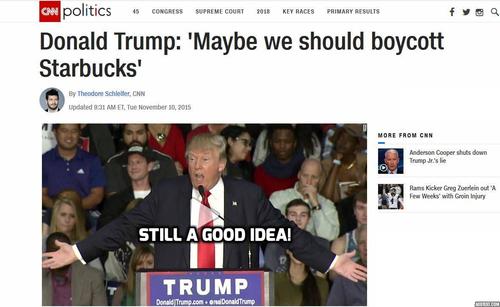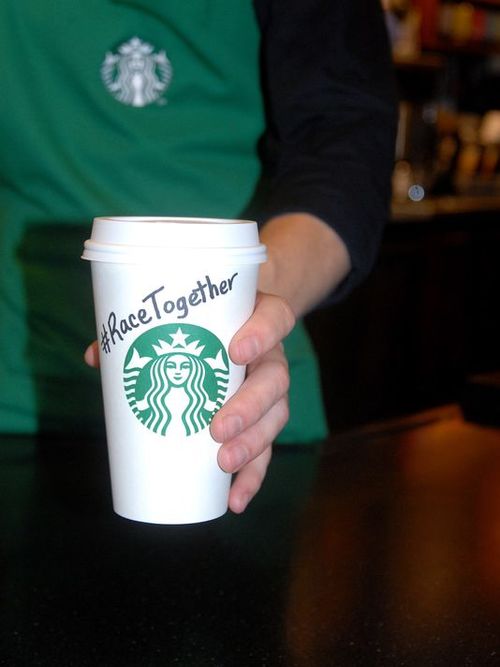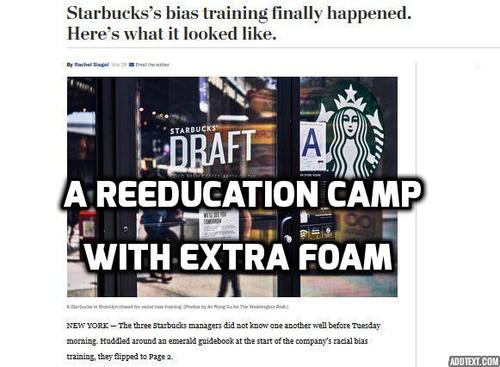


09/18/2018
Starbucks has been irritating white advocates, American nationalists, immigration restrictionists (but I repeat myself), and Christian conservatives for as long as it has been around. Some highlights of its Leftist corporate activism:



As long as this list is, I am confident in saying it is almost certainly not exhaustive. Starbucks consistently strives to discriminate against whites in its hiring practices, funds political and judicial causes that strive to ensure whites can continue to face legal discrimination, and does what it can to boost secularization and white guilt.
Most large companies in America are hostile towards the beliefs most every reader of this website have, but Starbucks is even worse than most.
Peter Bradley first suggested this in 2012, and I will reiterate it: we should boycott Starbucks. Do your best to go to Starbucks as infrequently as possible.

Love caffeine and enjoy the occasional indulgence? Buy a Red Bull, the Austrian energy drink.
The man behind Red Bull, Dietrich Mateschitz, may not be one us, but he is a lot closer to us than Starbucks ever will be. Though something of a recluse, his nationalistic and restrictionist instincts are understood. In his native Austria, he has vocalized his support for the Austrian Peoples Party in general, and its recent (successful) candidate, Sebastian Kurz. In an interview last year, Mateschitz criticized much of Europe’s decision to let in waves of “migrants” and expressed skepticism about the European Union’s bureaucratic grip on the continent. Better still, Mateschitz is currently putting together a German news outlet that many say will be akin to America’s Breitbart. [Red Bull’s CEO Loves Breitbart. Here’s Why the Art World Should Care., by Hili Perlson, Art Net, April 24, 2017]
Moreover, there is a profound and very telling difference in aesthetics between Red Bull and Starbucks. The Starbucks style is fairly well-known: wimpy retail-friendly “alternative” rock (e.g. Coldplay) is always playing softly, the employees all dole out that fake syrupy-sweet corporate customer service, and the idea of the place is to hang out indefinitely typing on your laptop and sipping lattes.
Red Bull promotes more or less the opposite — adventurous athleticism. The company is constantly promoting, and often sponsoring, all kinds of unique sporting events: from airplane races to soapbox races, from cliff diving to mountain bike races where tricks are mandatory. [9 Kick Ass Red Bull Events, by Jared O’Toole, Under30CEO.com] Red Bull even sent a daredevil into space a few years ago — that sounds made up but it is not — and we all know there is nothing whiter than space exploration. [World Record Jump, RedBullStrators.com] The company has a men’s lifestyle magazine, The Red Bulletin, that promotes these sorts of events, profiles the athletes that perform in them, etc. Unlike more typical “lad mags” such as Gentlemen’s Quarterly and Esquire, The Red Bulletin never delves into Leftist politics or vainly insists its readers get with the latest stupid fashion trend coming out of New York City.
In terms of the lifestyle each company promotes for its customers, Red Bull is far and away healthier than Starbucks.
Switching how we get caffeine for political reasons is also an American tradition. The whole reason Americans drink coffee to begin with is because we wanted to cheat the British Empire of turning a profit on our tea habit. The search for an equivalent energizer led us to coffee sourced from Brazil, the Caribbean, and Central America. Today America’s enemies are not found in distant military empires, but in domestic corporate empires, and the time has come to switch our caffeine source once again.
Interestingly, not a few dissidents of various stripes have already made the switch: the late Andrew Breitbart, Steve Bannon, and Identity Evropa founder Nathan Damigo all are/were Red Bull fanatics. Leftists, meanwhile, take a dim view of the drink. Here is a laugh-out-loud take on the matter from Huffington Post: “Science Confirms That Guys Who Like Energy Drinks Are Terrible,” by Erin Schumaker, November 12, 2015.
Making the change is easy. If you are at a Starbucks, there is sure to be a gas station or convenience store just around the corner, almost all of which stock Red Bull. Should you find yourself in need of a rush at Target, which almost always has a Starbucks within it, know that Target too carries Red Bull.
Worried about the cost? That critique is overhyped. Red Bull is normally between $2-$2.50 a can, which is decidedly expensive relative to a soda, but decidedly not expensive relative to most offerings at Starbucks — if anything, Red Bull is cheaper.
Find that it has too much sugar? Buy the sugar-free kind, which is just as readily available.
Not crazy about the taste? It is an acquired one, like many things. After all, did you like the taste of coffee or beer the first time you tried them?
After the aforementioned kerfuffle at the Philadelphia Starbucks involving the back non-customers and their defiant insistence that they be allowed to use the bathroom, Starbucks sheepishly announced that from there on out, you need not buy anything in order to use their bathrooms, or even the general seating. Everyone is now allowed to just go to Starbucks and hangout, like it were a library or a community center [Starbucks: You don’t need to buy anything to hang out in our stores, by Daniel Shane and Julia Horowitz, CNN Money, May 21, 2018].
So the next time you need to get some writing done, buy some Red Bulls and head to Starbucks. Buy nothing there, but use the free wi-fi and comfortable seating. You will need to bring some headphones though, as the music played at Starbucks is indeed unfailingly awful.
This may, or may not, describe what I am doing right now.
Hubert Collins writes regularly for American Renaissance and here at VDARE.com. You can follow him on Twitter here.